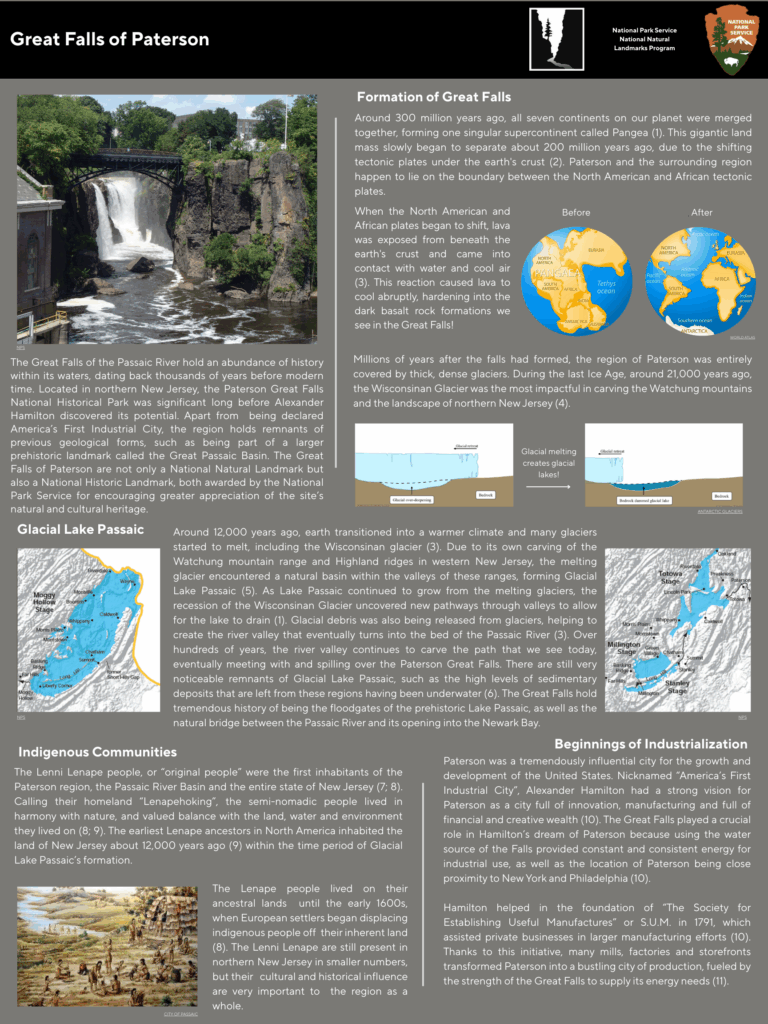by Stella Mueller
Intro
The Great Falls of the Passaic River hold an abundance of history within its waters, dating back thousands of years before modern time. Located in the center of northern New Jersey, the Paterson Great Falls was significant long before Alexander Hamilton discovered its existence. Apart from Paterson being declared America’s First Industrial City, the region holds detailed remnants of its previous geological forms, and its location is part of a larger prehistoric landmark called the Great Passaic Basin.
Lava flow and geological shape
The Great Falls are composed mainly of basalt, which is a dark, igneous rock that is formed through intense cooling and hardening of lava, or liquid rock (1). Around 300 million years ago, all seven continents on our planet were merged together, forming one singular supercontinent called Pangea (1). This gigantic land mass slowly began to separate about 200 million years ago, due to the shifting tectonic plates under the earth’s crust (2). Paterson and the surrounding region happen to lie on the boundary between the North American and African tectonic plates.
When the North American and African plates began to shift, lava was exposed from beneath the earth’s crust and came into contact with water and cool air (3). This reaction caused the lava to cool abruptly, hardening into the basalt rock formations we see in the Great Falls!
Glacial time period and retreatment
Millions of years after the falls had formed, the region of Paterson and northern New Jersey was entirely covered by thick, dense glaciers. During the Pleistocene epoch, or better known as the Ice Age, this region was the southernmost point of glacial reach and saw frequent ice expansion and recession (1, 4). As glaciers expand, they help to carve the landscape by scraping away dirt, sand and rocks as snow and ice sheets grow. When they begin to melt, the debris that is stuck within ice sheets is deposited, often settling debris in locations other than where they originate. The Wisconsinan Glacier, present in the region about 21,000 years ago, was the most impactful in carving the Watchung mountains and the landscape of northern New Jersey (5).
Around 12,000 years ago, earth transitioned into a warmer climate and many glaciers started to melt, including the Wisconsinan glacier (3). Due to the surrounding Watchung mountain range and Highland ridges in western New Jersey, the melting glacier encountered a natural basin within the valleys of these ranges (6). This allowed for melting glacial water to accumulate, creating an ancient lake known as Glacial Lake Passaic (1).
As Lake Passaic continued to grow from the melting glaciers, the recession of the Wisconsinan Glacier uncovered new pathways through valleys to allow for the lake to drain (1). Glacial debris was also being released from glaciers, helping to create the river valley that eventually turns into the bed of the Passaic River (3). Over hundreds of years, the river valley continues to carve the path that we see today, eventually meeting with and spilling over the Paterson Great Falls. There are still very noticeable remnants of Glacial Lake Passaic, such as the high levels of sedimentary deposits that are left from these regions having been underwater (7). The Great Falls holds tremendous history of being the floodgates of the prehistoric Lake Passaic, as well as the natural bridge between the Passaic River and its opening into the Newark Bay.
Local indigenous people
The Lenni Lenape people, or “original people” were the first inhabitants of the Paterson region, the Passaic River Basin and the entire state of New Jersey (8; 9). Their native homeland stretched beyond the state, reaching southern New York and Connecticut, along with Eastern Pennsylvania and Northern regions of Delaware (10).
Calling their homeland “Lenapehoking”, the semi-nomadic people lived in harmony with nature, and valued balance with the land and environment they lived on (9; 10). Often residing next to sources of water, the Lenape people relied on fishing, hunting and growing food on the lands they inhabited (9). They were skilled in farming, and were guided on ideal planting and harvesting periods of time based on the trajectory of the moon and stars (10).
The earliest Lenape ancestors in North America inhabited the land of New Jersey about 12,000 years ago (10) within the time period of Glacial Lake Passaic’s formation. The Lenape people lived on their ancestral lands uninterrupted until the early 1600s, when European settlers arrived and began displacing many tribes off of their inherent land (9). The Lenni Lenape are still present in northern New Jersey in smaller numbers, but their influence and cultural history are very important to many people and the region as a whole.
Transformation to today – explain about industrial aspect to paterson
The Great Falls not only holds significant ecological history but American history, as Paterson was a tremendously influential city for the growth and development of the United States. Nicknamed “America’s First Industrial City”, Alexander Hamilton had a strong vision for Paterson as a city full of innovation, manufacturing and full of financial and creative wealth (11). The Great Falls played a crucial role in Hamilton’s dream of Paterson because using the water source of the Falls provided constant and consistent energy for industrial use, as well as the location of Paterson being close proximity to New York and Philadelphia (11).
Hamilton helped in the foundation of “The Society for Establishing Useful Manufactures” or S.U.M. in 1791, which assisted private businesses in larger manufacturing efforts (11). Thanks to this initiative, many mills, factories and storefronts transformed Paterson into a bustling city of production, fueled by the strength of the Great Falls to supply its energy needs (12).
Conclusion
Whether you’re visiting the falls for its rich historical narrative, ancient environmental significance, or simply to take in the sights, the Paterson Great Falls is a sight worth seeing for everyone!
Great Falls of Paterson Poster
As part of this multimedia storytelling project, our team produced a series of posters for each site. You can view the poster for this site below, or scan the QR Code to view an augmented reality version. Note: if you are viewing this page on a mobile device, you can use this link to view the AR experience.


About the Author
Stella Mueller is a recent college graduate from the University of Rhode Island. She earned a M.S. in Environmental Communication in 2025, along with a B.A. in Journalism and a B.S. in Wildlife & Conservation Biology in 2024. During graduate school, Stella joined the DWELL Lab as a Communication Assistant, working in collaboration with the National Park Service to create updated multimedia products for NPS locations. She worked primarily with National Natural Landmark (NNL) sites in Northern New Jersey, where she designed updated posters, brochures and augmented reality (AR) experiences for park visitor engagement. Stella is currently pursuing a career in science communication and education, looking to share her appreciation for the natural world with future audiences.
Works cited:
- “Paterson’s Geology – a Step Back in Time – Paterson Great Falls National Historical Park (U.S. National Park Service).” Nps.gov, 2024, www.nps.gov/pagr/learn/nature/paterson-geology.htm.
- American Museum of Natural History. “Power of Plate Tectonics: Pangaea | AMNH.” American Museum of Natural History, www.amnh.org/explore/ology/earth/power-of-plate-tectonics/pangaea
- Paterson Great Falls National Historical Park. “A Brief Geology Lesson of Paterson Great Falls | Explore the Natural Wonders of the Great Falls with Ranger Kelsey, and Discover How the Falls Were Formed. #RangerChat #NationalParkWeek… | by Paterson Great Falls National Historical Park | Facebook.” Facebook.com, 2022, www.facebook.com/PatersonGreatFalls/videos/235091824420415.
- “Glaciers / Glacial Features – Morristown National Historical Park (U.S. National Park Service).” Nps.gov, 2015, www.nps.gov/morr/learn/nature/glaciers.htm. Accessed 2 May 2025.
- Witte, Ron W. Glacial Sediment and the Ice Age in New Jersey. NJ Geological Survey, 1998.
- U.S. Fish and Wildlife Service . “New Jersey’s Central Passaic Basin.” Fws.gov, Feb. 2007, www.fws.gov/sites/default/files/documents/Cent_Passaic_basin_508.pdf.
- Jones, Madison. “Central Passaic Basin (NNL /NPS/ESA).” Uri.edu, 2025, web.uri.edu/dwell/nnl-nps/.
- Passaic River Coalition. “Passaic River Watershed Issues.” Passaic River Coalition (PRC), passaicriver.org/passaic-river-basin/watershed-issues/.
- Licht, Walter, et al. “West Philadelphia Collaborative History – the Original People and Their Land: The Lenape, Pre-History to the 18th Century.” Collaborative History.gse.upenn.edu, 2024.
- Paterson Museum . “Paquapick – the Paterson Museum.” The Paterson Museum, 13 Nov. 2018, patersonmuseum.com/paquapick
- National Park Service. “The Birthplace of the American Industrial Revolution – Paterson Great Falls National Historical Park (U.S. National Park Service).” Nps.gov, 2016, www.nps.gov/pagr/learn/historyculture
- “History & Culture – Paterson Great Falls National Historical Park (U.S. National Park Service).” Www.nps.gov, 2025, www.nps.gov/pagr/learn/historyculture/index.htm.
